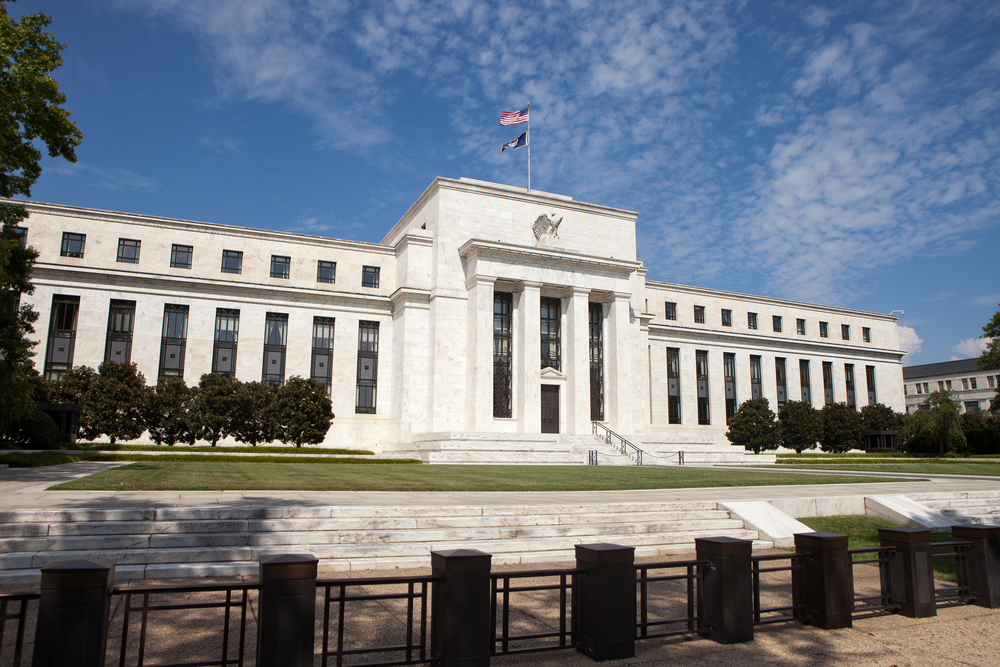It doesn’t take much investigation to see that the establishment, the global financial elite including the U.S. Federal Reserve, are very impressed with the technology that Bitcoin has brought to bear.
Also read: ESMT BERLIN BECOMES FIRST GERMAN UNIVERSITY TO ACCEPT BITCOIN
Every major corporation, brand, tech firm, even nations are spending thousands of man-hours researching and building mock-ups of Bitcoin’s blockchain technology. Blockchains, or “distributed ledger technology” (DLT) is ‘the next big thing’ in mainstream tech, and the U.S. Federal Reserve is no exception. They published a research paper about DLT yesterday.
The Biggest Dog in the Yard Has Noticed Bitcoin
The Bank of England, which paid homage to Bitcoin’s innovative concept dating back to 2014, may be the grand-daddy of the central banking concept, but the U.S. Federal Reserve is definitely the world’s most influential banking entity, controlling the global reserve currency, the U.S. Dollar. That they even bothered to do this shows the impact that Bitcoin has had worldwide in just eight years. This can’t be understated.
They published what they call a ‘research paper’ called “Distributed ledger technology in payments, clearing, and settlement” on Monday and I’ll go over the highlights, mentioning Bitcoin and its hidden meanings of relevance.
Let us start with what a blockchain, a DLT, is:
In the strictest sense, a distributed ledger is a type of database that is shared across nodes in a network. In a DLT arrangement, nodes are the devices running the DLT software that collectively maintain the database records. In this design, the nodes are connected to each other in order to share and validate information.
Obviously, the nodes in the global Bitcoin network are being referenced here, if not directly mentioned. The paper does mention a few times, but not too much as to give it too much credit for inventing this technology in its entirety. The implication is that a DLT might have started with Bitcoin, even if not mentioned directly, but it will evolve into more, even better, technology in the greater banking mainstream.
Let’s look at Bitcoin being referenced, directly:
Cryptocurrency DLTs, such as Bitcoin, are generally open systems. Many DLT arrangements being contemplated by the financial industry, however, are envisioned as closed.
This is about as accurate and straightforward as The Fed will get on this subject. No one can deny that Bitcoin is designed to be opens-source and any centralized banking system concept will be a closed network. Think of the Internet versus an office “intranet,” and all of the pros and cons of each system that entails. History will definitely repeat itself here.
It’s All About Control. Their Control.
Expanding on that narrative, let’s look at methods of control within their closed-network:
Cryptocurrency DLT arrangements, such as Bitcoin, are examples of permissionless systems. The financial industry, however, is focused mainly on developing permissioned systems because these systems offer a way to provide controls over important functions performed in the arrangement.
Not much to add here. It’s all about control, isn’t it? This is important to contemplate when it comes to a future of nationalized digital currencies that will run on this design philosophy. Do you want every national currency transaction of yours to be run through a “permissioned system?”
Other concepts popularized in the decentralized digital currency realm were also referenced, like smart contracts. The paper defines them as “…coded programs that are used to automate pre-specified transactional events based on agreed upon contractual terms.”
The benefits of using a blockchain, or DLT, versus the outmoded intermediary systems of the last few decades, are listed clearly, implying that these will be integrated first in a system as large and important as the Federal Reserve. The clear advantages of going DLT include:
- Reduced complexity (especially in multiparty, cross-border transactions);
- Improved end-to-end processing speed and availability of assets and funds;
- Decreased need for reconciliation across multiple record-keeping infrastructures;
- Increased transparency and immutability in transaction record-keeping;
- Improved network resiliency through distributed data management;
- Reduced operational and financial risks.
More Bitcoin Advantages
Another advantage Bitcoin has shown over the status quo is the fast and effective ability to international payments, versus a wire transfer or SWIFT system, which are both generations old, and are filled with time-wasting, identity-compromising flaws. No banking establishment member has figured out a solution to these problems over the years, much less one as elegant in its simplicity and effectiveness as Bitcoin. The Fed explains:
Numerous firms have identified the slow, indirect, and expensive settlement of cross-border payments as a current point of friction that could be alleviated through the application of DLT arrangements. Depending on the jurisdiction and the banks involved, costs are generally passed on to the end-users and may be deducted from the face amount of the funds transferred.
The last sentence there is not to be ignored. This paper also speaks of Ethereum’s DAO fiasco this summer and what they took from that, of course using that as leverage for the benefits of having a centralized ruler of all networks.
The 2016 hack of the Decentralized Autonomous Organization (DAO) demonstrated the challenges of having a decentralized governance arrangement that requires consensus of the network to deploy changes.
Is Their Flawed Economic System Now Obsolete?
In closing, the best way to wrap this up is for them to address their own paradigm’s flickering long-term value against this onslaught of faster, better technology. If we have already seen a technology that can pass your old system almost instantaneously, well, what the hell do we need you bankers/broker-dealers around for anyway? Give them credit for at least broaching the question, in writing. This is how they try and get in front of the issue:
Some have raised the possibility that DL technology may make financial intermediaries obsolete. One cannot rule out long-run changes in the roles and responsibilities of intermediaries in financial markets and the demand for their services. However, intermediaries play important roles in matching borrowers and savers in the economy, providing safe monetary instruments that form the basis of the payment system, aggregate financial activity and more. It is far from clear that these functions will all become obsolete in the foreseeable future.
Will the Federal Reserve succeed in tapping Bitcoin’s blockchain technology? Share your thoughts below!
Images courtesy of shutterstock










